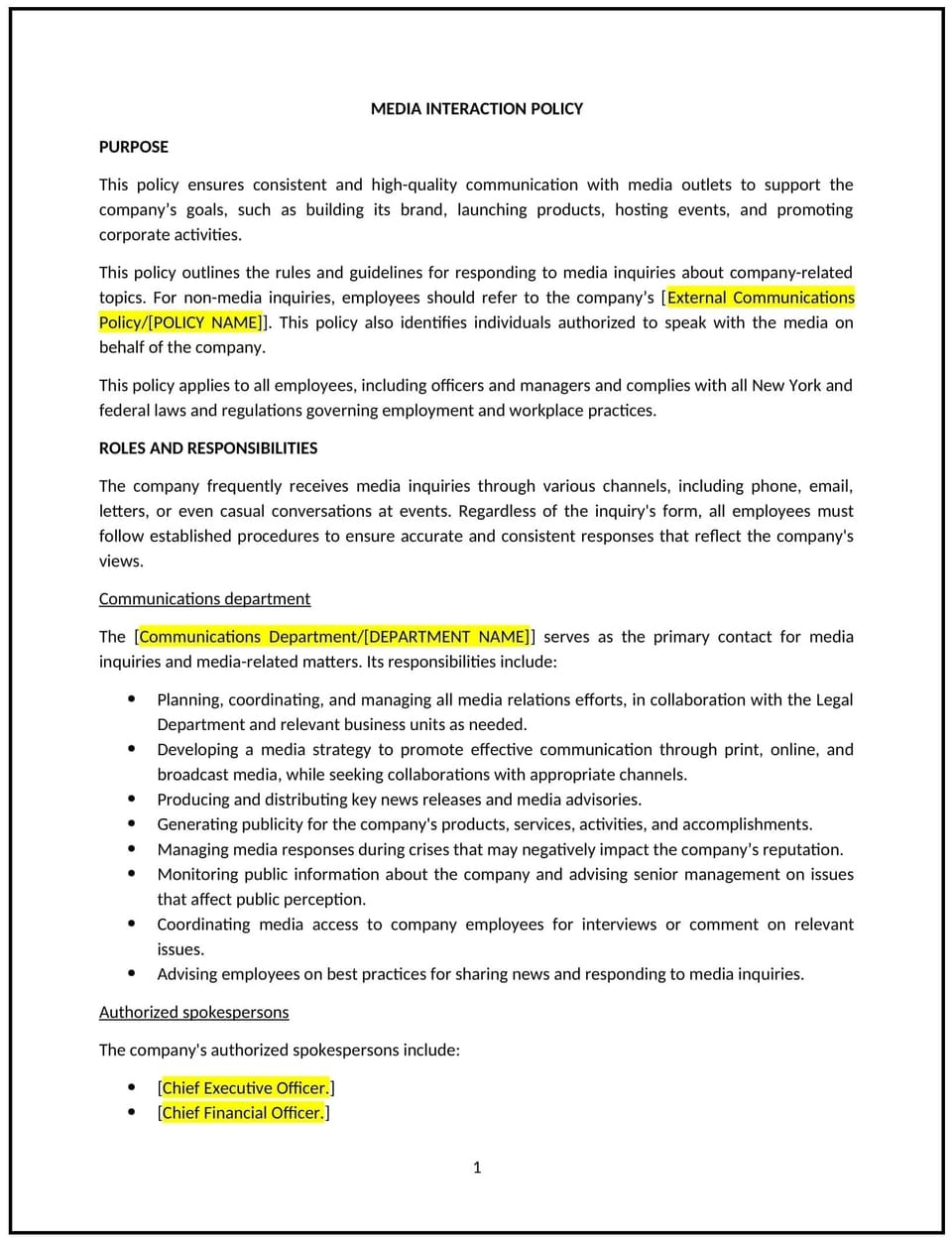Media relations policy (New York): Free template

Media relations policy (New York)
This media relations policy is designed to help New York businesses establish clear guidelines for managing interactions with the media. Whether businesses are responding to inquiries, issuing press releases, or proactively sharing updates, this template provides a structured approach to maintain professionalism, consistency, and protect the company’s reputation.
By adopting this template, businesses can streamline media communication processes, reduce risks, and foster strong relationships with the media.
How to use this media relations policy (New York)
- Define authorized spokespersons: Identify the employees or roles (e.g., PR team, senior executives) responsible for speaking to the media on behalf of the business.
- Establish communication procedures: Outline the steps for handling media inquiries, including how requests should be routed and approved before responses are given.
- Provide content guidelines: Include expectations for crafting professional and consistent messaging that aligns with the company’s values and goals.
- Address proactive media outreach: Specify the process for issuing press releases, scheduling interviews, or pitching stories to the media.
- Highlight confidentiality requirements: Emphasize the importance of protecting sensitive or proprietary information in all media interactions.
Benefits of using a media relations policy (New York)
This policy offers several benefits for New York businesses:
- Protects the company’s reputation: Clear guidelines help maintain professionalism and ensure accurate, consistent messaging to the media.
- Streamlines media management: Structured procedures reduce delays in responding to media inquiries and minimize the risk of miscommunication.
- Reduces risks: Limiting media interactions to authorized spokespersons mitigates the risk of disclosing inaccurate or confidential information.
- Enhances public perception: Thoughtful and consistent communication fosters positive relationships with the media and the public.
- Supports crisis management: Clear protocols help businesses navigate media interactions effectively during crises or sensitive situations.
Tips for using this media relations policy (New York)
- Train authorized spokespersons: Provide media training to employees designated as spokespersons to ensure they communicate confidently and professionally.
- Develop message templates: Create standard templates for common media scenarios, such as press releases or responses to inquiries, to maintain consistency.
- Monitor media coverage: Regularly track media mentions of the business to identify opportunities or address inaccuracies promptly.
- Use centralized approval processes: Implement a single point of review for all media communications to ensure accuracy and alignment with business objectives.
- Review and update regularly: Update the policy to reflect changes in media strategies, business goals, or New York-specific regulations.
Q: Who should be authorized to speak to the media?
A: Authorization is typically limited to designated spokespersons, such as members of the PR team or senior leadership, to maintain consistent messaging.
Q: How should businesses handle unsolicited media inquiries?
A: All unsolicited inquiries should be routed to the authorized spokesperson or PR team, who will assess the request and determine the appropriate response.
Q: What should businesses include in a press release?
A: Press releases should include a clear headline, a concise summary of the announcement, key details, and contact information for follow-up inquiries.
Q: How can businesses manage negative media coverage?
A: Negative coverage should be addressed promptly by engaging the media professionally, clarifying inaccuracies, and issuing a statement if necessary.
Q: How often should this policy be reviewed?
A: The policy should be reviewed annually or when significant changes occur in media strategies or business operations.
This article contains general legal information and does not contain legal advice. Cobrief is not a law firm or a substitute for an attorney or law firm. The law is complex and changes often. For legal advice, please ask a lawyer.


